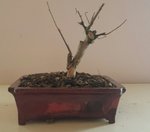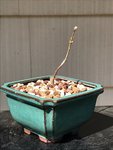Frank, how is that any different than cutting back the underside of a trunk when repotting? I often take my large root pruners and nibble away at the base of a trunk from underneath, creating a flat base of the rootball. Maybe I’m just lucky, but I’ve never seen any rot from doing this.
It is somewhat the same Adair, except when first severing an air layer the percentage of healthy roots is much smaller than when progressively reducing the base of an otherwise healthy tree. Also the severed portion may not grow well if not kept in the best of circumstances and optimum moisture conditions. And as I noted some species handle it extremely well, specially the vigorous deciduous such as Trident maple! However, the topic was, is it safe to recommend for all species and does it have some drawbacks? Actually it was Boon who first indicated to me that it can often lead to complications in some species and is not a recommended practice for others. We were discussing handouts in an intensive class June of 2010. When I check my written notes on the one handout the comment was" the air layer process is very long term and root grafting will give better results in a shorter period of time" The other handout indicates " the scar in the middle of the roots is due to the fact this tree was obtained by layering. Since the tree did not grow strongly and the wound did not deal well, a little of the wood has rotted. This part must be treated painstakingly so that it will callus over properly." The two handouts in question were focussed on creating Bonsai from deciduous trees.
I have seen quite a few examples of trees with hollowed out trunks to compensate for the issue arising after air layering!
It has not happened to me. Many of the recommendations are for quite a variety of species, not all of which are suitable for air layering. plus the fact that very few practitioners condition their trees prior to using the technique. I do not think it is "luck" more likely associated with proper technique, clean tools, proper substrate, effective watering and starting with healthy vigorous trees to begin with.








